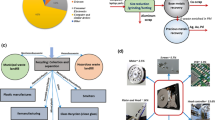Abstract
Currently only limited materials, such as common metals and plastics, are recovered from waste flat-panel displays, thus necessitating the development of a comprehensive recycling process. This study aims to establish a statistical database about the types and amounts of valuable resources in waste liquid crystal display (LCD) products. To obtain these data, the waste LCD products were disassembled into four components: plastics, printed circuit boards, metals, and other materials, including their panels, and the weight of each component was measured. Overall, the product weight decreased with increasing manufacturing year regardless of the product screen size; however, the decreasing rate varied from 14 to 73%. The metal weight ratios decreased significantly by 24–31%. Meanwhile, regardless of the manufacturing year, the plastic weight ratios remained almost constant at about 20%. On the other hand, the weight ratio of the other components increased by 26–46% with increasing manufacturing year suggesting that rare-earth metal recycling has become more important. These statistical analyses are expected to contribute to the development of an eco-friendly, high-efficiency dismantling/separation process that will enable higher value recycling and minimal waste disposal.







Similar content being viewed by others
References
Hong HS, Lee HM, Kong M, Kang HY (2010) Overview and future concerns for LCD wastes recycling technology. J KSMER 47(5):619–627 (uci: G704-000204.2010.47.5.013)
Kristofer E, Sundin E (2014) Process concepts for semi-automatic dismantling of LCD televisions. Proc CIRP 23(1):270–275. https://doi.org/10.1016/j.procir.2014.10.104
Hong MH, Park K-S, Swain B, Kang L-S, Suk HG, Hong HS (2015) Efficient recycling of printed circuit boards from disassembly/separation process of waste LCD TVs: composition analysis and value-wise classification. J Korean Inst Resour Recycl 24(1):66–72. https://doi.org/10.7844/kirr.2015.24.1.66
Lee S, Kang L, Lee CG, Hong MH, Cho S-S, Hong HS (2013) Disassembly and compositional analysis of waste LCD displays. J Korean Inst Resour Recycl 22(2):29–36. https://doi.org/10.7844/kirr.2013.22.2.29
Shin D, Kang L, Park JL, Lee CG, Yoon J-H, Hong HS (2015) Current research trend on recycling of waste flat panel display panel glass. J Korean Inst Resour Recycl 24(1):58–65. https://doi.org/10.7844/kirr.2015.24.1.58
Ueberschaar M, Schlummer M, Jalalpoor D, Kaup N, Rotter VS (2017) Potential and recycling strategies for LCD panels from WEEE. Recycling 2(1):7. https://doi.org/10.3390/recycling2010007
Bhakar V, Agur A, Digalwar AK, Sangwan KS (2015) Life cycle assessment of CRT, LCD and LED monitors. Proc CIRP 29:432–437. https://doi.org/10.1016/j.procir.2015.02.003
Li J, Gao S, Duan H, Liu L (2009) Recovery of valuable materials from waste liquid crystal display panel. Waste Manag 29(7):2033–2039. https://doi.org/10.1016/j.wasman.2008.12.013
Movilla NA, Zwolinski P, Dewulf J, Mathieux F (2016) A method for manual disassembly analysis to support the ecodesign of electronic displays. Resour Conserv Recycl 114(1):42–58. https://doi.org/10.1016/j.resconrec.2016.06.018
Li J, Zeng X, Chen M, Ogunseitan OA, Stevels A (2015) “Control-alt-delete”: rebooting solutions for the e-waste problem. Environ Sci Technol 49(12):7095–7108. https://doi.org/10.1021/acs.est.5b00449
Zeng X, Song Q, Li J, Yuan W, Duan H, Liu L (2015) Solving e-waste problem using an integrated mobile recycling plant. J Clean Prod 90(1):55–59. https://doi.org/10.1016/j.jclepro.2014.10.026
Böni H, Widmer R (2011) Disposal of flat panel display monitors in Switzerland, final report. Swiss Federal Laboratories for Materials Science and Technology, St. Gallen
Park JL, Lee S, Kang L, Lee CG, Cho S-S, Hong MH, Hong HS (2014) Decontamination of mercury contained in CCFLs (cold cathode fluorescence light) disassembled from waste LCDs (liquid crystal display). J Korean Inst Resour Recycl 23(2):61–70. https://doi.org/10.7844/kirr.2014.23.2.61
Cryan J, Freegard K, Morrish L, Myles N (2010) Demonstration of flat panel display recycling technologies. Waste and Resources Action Programme, Banbury
Zeng X, Yang C, Chiang JF, Li J (2017) Innovating e-waste management: from macroscopic to microscopic scales. Sci Total Environ 575(1):1–5. https://doi.org/10.1016/j.scitotenv.2016.09.078
Ryan A, O’Donoghue L, Lewis H (2011) Characterising components of liquid crystal displays to facilitate disassembly. J Clean Prod 19:9–10. https://doi.org/10.1016/j.jclepro.2011.01.009 1066–1071.
Kristofer Elo E Sundin (2014) Automatic dismantling challenges in the structural design of LCD TVs. Proc CIRP 15:251–256. https://doi.org/10.1016/j.procir.2014.06.058
Rocchetti L, Amato A, Beolchini F (2016) Recovery of indium from liquid crystal displays. J Clean Prod 116:299–305. https://doi.org/10.1016/j.jclepro.2015.12.080
Swain B, Mishra C, Hong HS, Cho S-S (2016) Beneficiation and recovery of indium from liquid-crystal-display glass by hydrometallurgy. Waste Manage 57:207–214. https://doi.org/10.1016/j.wasman.2016.02.019
Zeng X, Wang F, Sun X, Li J (2015) Recycling indium from scraped glass of liquid crystal display: process optimizing and mechanism exploring. ACS Sustainable Chem Eng 3(7):1306–1312. https://doi.org/10.1021/acssuschemeng.5b00020
Zhang K, Wu Y, Wang W, Li B, Zhang Y, Zuo T (2015) Recycling indium from waste LCDs: a review. Resour Conserv Recycl 104A:276–290. https://doi.org/10.1016/j.resconrec.2015.07.015
Silveira AVM, Fuchs MS, Pinheiro DK, Tanabe EH, Bertuol DA (2015) Recovery of indium from LCD screens of discarded cell phones. Waste Manage 45:334–342. https://doi.org/10.1016/j.wasman.2015.04.007
Wang R, Chen Y, Xu Z (2015) Recycling acetic acid from polarizing film of waste liquid crystal display panels by sub/supercritical water treatments. Environ Sci Technol 49(10):5999–6008. https://doi.org/10.1021/acs.est.5b00104
Rocchetti L, Amato A, Fonti V, Ubaldini S, De Michelis I, Kopacek B, Vegliò F, Beolchini F (2015) Cross-current leaching of indium from end-of-life LCD panels. Waste Manage 42:180–187. https://doi.org/10.1016/j.wasman.2015.04.035
Yang J, Retegan T, Steenari B-M, Ekberg C (2016) Recovery of indium and yttrium from flat panel display waste using solvent extraction. Sep Purif Technol 166:117–124. https://doi.org/10.1016/j.seppur.2016.04.021
Luling Y, Zhuang X, Bai L, Li F, He W, Li G, Huang J (2016) Acetic acid production from the hydrothermal transformation of organics in waste liquid crystal display panels. J Clean Prod 113:925–930. https://doi.org/10.1016/j.jclepro.2015.11.056
Chen CC, Chang FC, Peng CY, Wang HP (2015) Conducting glasses recovered from thin film transistor liquid crystal display wastes for dye-sensitized solar cell cathodes. Environ Technol 36(23):3008–3012. https://doi.org/10.1080/09593330.2014.982206
Acknowledgements
This study was supported by the R&D Center for Valuable Recycling (Global-Top R&D Program) of the Ministry of Environment (no. 2016002250005).
Author information
Authors and Affiliations
Corresponding author
Rights and permissions
About this article
Cite this article
Hong, H.S., Choi, A.R. Quantitative characterization of recyclable resources dismantled from waste liquid crystal display products. J Mater Cycles Waste Manag 20, 2054–2061 (2018). https://doi.org/10.1007/s10163-018-0758-x
Received:
Accepted:
Published:
Issue Date:
DOI: https://doi.org/10.1007/s10163-018-0758-x




